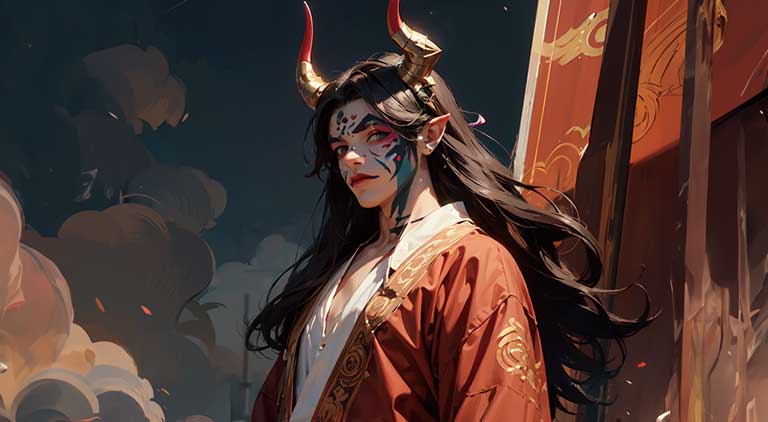Ura (温羅 / おんら) (Ura/Onra)
Overview
Ura is a legendary demon or figure reputed to have been a ruler in ancient Kibino. Known by alternate names such as “Kishin” or “Kibi Kajya,” some central traditions claim that Kibino was administered by the deity Kibi-tsuhiko; however, local legends in Kibino maintain that Ura was defeated by Kibi-tsuhiko.
Legends and Background
- The Legend as a Ruler
Ura is celebrated as a powerful ruler of ancient Kibino, his authority described in terms befitting a demon-god. - The Formation and Transformation of the Legend
The current form of Ura’s legend is believed to have been established no later than the end of the Muromachi period, with various written origins detailing his myth. - Connection to Momotaro
Some theories suggest that Ura’s legend may have served as a motif for the story of Momotaro, influencing later folktales and legends.
Cultural Significance
Ura embodies a fusion of ancient regional authority and demonic terror. His legend reflects the historical and cultural identity of the Kibino region and has significantly influenced subsequent heroic narratives and folk traditions.
Konheika (金平鹿) (Konheika)
Overview
Konheika is a demon general reputed to have wreaked havoc upon the seas of Kumano in Kii Province. Some historical texts refer to him as “Pirate Tagamaru.” He is said to have made his base at a demon-infested cave in the Kumano-nada, commanding a vast retinue of subordinate demons.
Legends and Background
- The Sea-Dominating Demon-God
Konheika is closely associated with the turbulent maritime region of Kii, particularly the Kumano-nada, and is linked with the fearsome power of the stormy seas. - Pirate-like Nature
Due to his notorious conduct, he is considered to have pirate-like qualities, bringing calamity to ships and coastal settlements. - Retinue and Base
Legend holds that he commanded many subordinate demons from his lair in a cave, an image that symbolizes both the ferocity of nature and the harshness of the sea.
Cultural Significance
Konheika epitomizes the wild, untamable power of the sea and the supernatural threats that lurk beneath its surface. His legend has deeply influenced local folk beliefs and maritime folklore, serving as a recurring motif in literature and art that explore the mysteries and dangers of the ocean.
Fujiwara Chikata’s Four Demons (藤原千方の四鬼) (Fujiwara Chikata no Yonki)
Overview
Fujiwara Chikata’s Four Demons are legendary creatures from Tsushi in Mie Prefecture. During the Heian period, the powerful noble Fujiwara Chikata is said to have commanded these four demons in his rebellion against the imperial court. However, his uprising was thwarted by the poetic prowess of Kinomotoo, which scattered the four demons and ultimately led to Fujiwara Chikata’s downfall.
Kinki (金鬼)
Characteristics
Kinki is renowned for his incredibly sturdy body, capable of repelling any weapon. He is considered the toughest and most resilient among the demons.
Fūki (風鬼)
Characteristics
Fūki possesses the power to control strong winds, capable of blowing enemies away. His gusts are said to be so powerful that they can transform the very battlefield with their destructive force.
Suiki (水鬼)
Characteristics
Suiki is adept at generating floods in any environment, drowning his foes with water. His command over water is so formidable that it can completely alter the course of a battle, rendering escape impossible for his enemies.
Ongyōki (隠形鬼)
- Characteristics
Ongyōki is capable of vanishing without a trace, allowing him to launch surprise attacks on his adversaries. Sometimes referred to as “Onkyōki,” his ability to become nearly invisible on the battlefield makes him one of the most troublesome and feared demons.
Thus, Fujiwara Chikata’s Four Demons each possess unique supernatural abilities, making them formidable threats on the battlefield. According to legend, these demons bolstered Fujiwara Chikata’s rebellion until Kinomotoo’s poetry scattered them, ultimately leading to his downfall.
In conclusion, the 33 terrifying oni featured in this article offer a window into the mysterious and formidable world of Japanese demons. Their legends—rich with symbolism, terror, and ancient wisdom—highlight how deeply these creatures are woven into Japan’s cultural fabric. From their wrathful retribution to their uncanny supernatural powers, these oni not only serve as cautionary figures but also ignite our imagination with the enduring allure of the unknown. May this exploration inspire you to further uncover the dark, mystical depths of Japanese folklore and appreciate the timeless art of myth-making.
Reference: Wikipedia – 鬼


Comments